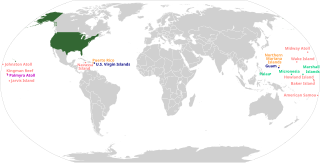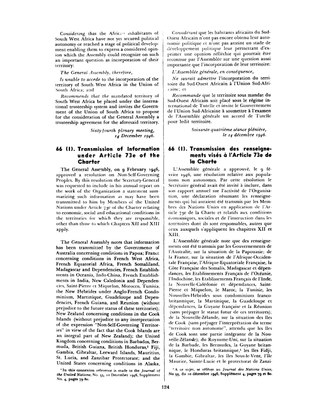
A referendum is a direct vote by the electorate on a proposal, law, or political issue. This is in contrast to an issue being voted on by a representative. This may result in the adoption of a new policy or specific law, or the referendum may be only advisory. In some countries, it is synonymous with and also known as plebiscite, votation,popular consultation, ballot question, ballot measure, or proposition.

The 51st state is an American political discourse term that refers to areas that are considered to be candidates for U.S. statehood, joining the current 50 states that have already been constituted in the United States since 1959. The phrase has been applied to external territories, as well as the country's capital for the District of Columbia and parts of already-existing states which would be admitted as separate states in their own right.

Chapter XI of the United Nations Charter defines a non-self-governing territory (NSGT) as a territory "whose people have not yet attained a full measure of self-government". In practice, an NSGT is a territory deemed by the United Nations General Assembly (UNGA) to be "non-self-governing". Chapter XI of the UN Charter also includes a "Declaration on Non-Self-Governing Territories" that the interests of the occupants of dependent territories are paramount and requires member states of the United Nations in control of such territories to submit annual information reports concerning the development of those territories. Since 1946, the UNGA has maintained a list of non-self governing territories under member states' control. Since its inception, dozens of territories have been removed from the list, typically when they attained independence or internal self-government, while other territories have been added as new administering countries joined the United Nations or the General Assembly reassessed the status of certain territories.

An independence referendum was held in the Faroe Islands, an autonomous territory of Denmark, on 14 September 1946. Although a narrow majority of valid votes were cast in favour of the proposal (50.7%), the number of invalid votes exceeded the winning margin. Although independence was declared by the Speaker of the Løgting on 18 September 1946, the declaration was not recognised by Denmark. Danish King Christian X dissolved the Løgting and called fresh elections, which were won by unionist parties. The islands were subsequently given a greater level of self-rule.
General elections were held in Guam on November 7, 2006, in order to elect the governor, all 15 seats in the Legislature and the federal delegate. There was also a double referendum on legalise slot machines at racing tracks and raising the age at which citizens could purchase and consume alcohol to 21.

The Puerto Rico statehood movement aims to make Puerto Rico a state of the United States. Puerto Rico is an unincorporated territorial possession of the United States acquired in 1898 following the Spanish–American War, making it "the oldest colony in the modern world". As of 2019, the population of Puerto Rico is 3.2 million, around half the average state population and higher than that of 20 U.S. states. Competing options for the future political status of Puerto Rico include maintaining its current status, becoming fully independent, or becoming a freely associated state. Puerto Rico has held six referendums on the topic. These are non-binding, as the power to grant statehood lies with the US Congress. The most recent referendum was in November 2020, with a majority (52.52%) of those who voted opting for statehood.

A referendum on the islands' status was held in the Federated States of Micronesia on 21 June 1983. Voters were asked two questions. The first was on whether they approved of the Compact of Free Association between the FSM and the United States. The second was what their preference was if Free Association was rejected. Voters were presented with the option of independence or an alternative which they had to fill in on the ballot form.
A referendum on the political status of Puerto Rico was held in Puerto Rico on November 6, 2012. It was the fourth referendum on status to be held in Puerto Rico. Puerto Rico has been an unincorporated territory of the United States since the Spanish–American War in 1898.
An independence referendum was held in New Caledonia on 13 September 1987. Voters were given the choice of remaining part of France or becoming independent. The referendum was boycotted by independence movements. Only 1.7% voted in favour of independence.
A referendum on union with the Northern Mariana Islands was held in Guam on 4 November 1969. The proposal was rejected by 58% of voters due to fears about an increase in taxation. Despite the result, a similar referendum was held in the Northern Mariana Islands on 9 November in which 61% of voters supported union with Guam.
A referendum on the territory's status was held in Guam on 4 September 1976. Voters were presented with a range of options, with "improved status quo" receiving the support of 58%.
A two-part referendum was held in Guam on 4 August 1979. A proposed new constitution was rejected by 82% of voters, whilst a law introducing the death penalty was rejected by 53% of voters. In August 1987 a referendum was held on another proposed constitution, with each chapter voted on separately. Two chapters were rejected by voters, resulting in a second referendum in November in which both were approved.
A referendum on the territory's status was held in Guam on 30 January 1982. Although the option of becoming a US commonwealth received the most votes, it did not achieve a majority. As a result, a second referendum was held in September with only two options.
A referendum on introducing balanced budgets was held in Guam on 1 November 1986. Although more voters voted "yes" than "no", the Santos Amendment had required that the referendum required at least 50% of all votes in favour to pass. As a result, the proposal was rejected.

An unofficial referendum on integration with Guam was held in the Northern Mariana Islands on 27 October 1963. Although the proposal was approved by voters, the islands were not integrated.

A referendum on the islands' status was held in the Northern Mariana Islands on 5 February 1961. Although 65% of voters supported integration with Guam, the United States did not integrate the islands.

A referendum on the islands' status was held in the Northern Mariana Islands on 9 November 1969. For the fourth time since 1958 a majority of voters supported integration with Guam. However, a referendum held in Guam on 4 November on integration with the Northern Mariana Islands had been rejected by 58% of Guamanian voters.

A referendum on becoming a US commonwealth was held in the Northern Mariana Islands on 17 June 1975. The proposal was approved by 79% of voters. As a result, the United States Congress approved the change of status on 24 March 1976.
A referendum on legalising slot machines at greyhound racetracks was held in Guam on 5 January 2008. The proposal was rejected by 63% of voters.
Two constitutional referendums were held in Guam in 1987.







